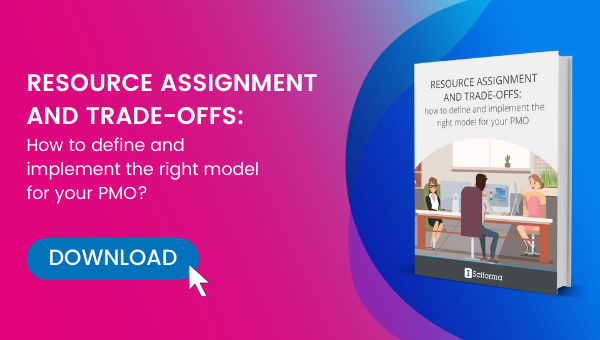Effective and efficient project resource management requires matching inbound work demand with available resource supply. With the right resources management system, PMOs can streamline execution, maximize resource utilization, and increase project profitability. Let’s dive in to discover how a resource management-oriented PPM system can benefit your organization’s visibility, planning, scheduling, and more.
Resource Management 101
Optimizing capacity planning and resource management is a key prerequisite for effective project portfolio management (PPM). However, PMOs and PM professionals often find it difficult to best utilize their organization’s human, technical, and financial resources.
Resource management is all about ensuring the right people have the right tools to do work at the right times. Excellence in resource management requires not only a top-notch resource allocation process, but also a robust system to maximize their utilization rate.
What is at stake is no less than the success of your business. Effective resource management should be based on accurate project costing and scheduling. This will boost productivity, improve customer relationships and satisfaction via predictability, increase employee engagement, and facilitate hiring decisions.
While manual determination of resource management optima can prove to be a real headache, project organizations can leverage purpose-made software tools like Sciforma to help facilitate, accelerate, and improve the quality of the process.
Prerequisites for an Effective Resources Management System
When it comes to managing project resources, success can be defined as the enterprise’s ability to staff the right resources on the right activities and projects while maximizing the overall utilization rate. This definition carries a number of implications:
- A firm’s productive resources are not equal. While some can be defined as “critical” to the business — either because they are rare and cannot be replaced easily, because they are costly, or because they have the unique skills or capabilities that help the firm stand out on the market — others are objectively less important to the survival and success of the organization. You need to take that difference into account when allocating resources to team members. Those projects with the highest potential return and strategic value should take priority when it comes to accessing critical resources.
- Finding and maintaining the perfect resource utilization rate is essential in order to maximize the return on resource investment, including labor expenses. On the one hand, paying high-skill workers full-time to have them work only part-time is obviously a waste of money. On the other hand, overworking your staff is hardly the way to go to attract and retain top talent. In fact, overworking is the leading cause of work-related stress among employees. But finding the sweet spot requires the ability to forecast work demand and resource capacity. This is where a resource management-oriented PPM system can come into play.
- Both the availability of resources and the schedules and requirements of projects may evolve over time. This means that organizations and PMOs need to track shifts in demand and resource supply and course-correct proactively when needed. This will maintain a healthy balance between work demand and resource supply.
Visibility for Effective Resource Management
Poor performance of resource allocation/utilization often stems from a lack of visibility and clarity into the resource pool. If that supply matches demand over time, you need to be able to understand and track both supply and demand. Here’s how a resource-management-oriented PPM tool can help.
A Project Portfolio Management system provides a centralized repository offering an up-to-date overview of all project-related data. You get instant, anytime, anywhere access to a high-level view of your resource pool, with the ability to check availability and analyze what a project requires at a glance.
PPM systems also provide an array of solution capabilities to filter, sort, and categorize human resources by role, by skill, by location, and by other attributes. This overview or resource qualifications and bandwidth can be matched and compared with a similar big picture view of the requirements of active and upcoming projects.
Resource management software like Sciforma also includes automatic features to balance supply and demand and to detect anomalies and discrepancies. Visual-led screens and calendars make the information easy to understand, to digest, and to report.
Our best-in-class resource management tool empowers project leaders to manage time tracking, resource allocation, and more key information that helps businesses continue to improve performance even against deadlines and financial goals..
Why Your Resource Management System Should Be Flexible and Comprehensive
The process used to allocate and manage resources may vary considerably from one organization to the next, depending on a number of market and organizational factors, such as the level of detail and granularity required for resource assignment, or the respective responsibilities of the various stakeholders involved in resource management (Project Managers and Resource Managers, the PMO, Project Owners, and so forth) and the way they interact.
What’s more, the process embraced by a given organization may evolve over time due to shifts in the business environment. This is why it is essential to opt for a resource management system that supports every option and opportunity.
- For example, many businesses and PMOs use soft allocations for tentative projects. (This means allocating a generic role before deciding on a named resource.)
- According to your company’s geographical location and line of business, you may prefer assigning resources by the hour, by the day, or go for a mix of both. Your resource management platform should ideally offer either option.
- A proper PPM system should enable you to assign resources to activities, projects, programs, or even entire portfolios. Most organizations have to distribute a fixed pool of shared resources across multiple initiatives. Your PPM and resource management system should therefore support dependency analysis to help prevent and resolve resource assignment conflicts across projects.
- Finally, PMOs need the ability to assess future work requirements and capacity in order to achieve realistic projections. PPM system functionalities such as pre-set project models suggesting standard resource requirements for a project, real-time views and reports for resources, and scenario simulation capabilities will help to anticipate — and therefore to better prioritize projects and/or to make the capacity adjustments ahead of time.







